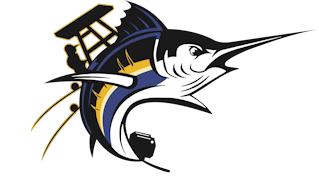 |
Welcome to the Reel Boating Forum.
From Trailer Boaters to Captains to Marine Industry Professionals, the Reel Boating Forum welcomes you to join in with other boaters and fishermen discussing topics including sportfishing, marine electronics, boating safety, boat engines and more. Use our FREE boat classifieds to sell your boat or fishing gear. Marine Industry Vendors are also welcome to register a username and freely post their products or services |

Fubar512
-
Posts
99 -
Joined
-
Last visited
Content Type
Profiles
Forums
Events
Posts posted by Fubar512
-
-
Put in a morning's fishing today, with my friend Capt. Pete Ferraro, on his classic Mako 231, the "Fishing' Inferno. Caught 20+ Stripers, 5 of which were keepers. We released the largest fish, a 39" long female. Also have a video of the trip, which I'm presently editing
 I'll upload it as soon as I deem it "family friendly"
I'll upload it as soon as I deem it "family friendly" 
-
how do I embed?
Place the Youtube video's address inside the following tags, like so (without the quotes, of course!)
["youtube"] youtube address ["/youtube"]
-
That was epic! BTW, You can embed a youtube video on this website...
-
While helping Auguste find a suitable boat during the Spring of last year, we checked out several boatyards in and around my old Summer stomping grounds, in Point Pleasant and Brick, NJ. Gus commented several times on my knowledge of the area, such as where the various boat yards (and the best pizzerias) were located.
Every Summer from 1972-1975, I would spend two weeks with my friend and his family at their Summer place in Bayhead, NJ. To pass the time (when we got bored of fishing, crabbing, and swimming), we'd jump on our bicycles and go off exploring, oftentimes staying out until past suppertime. A couple of times, we neglected to check in via payphone, and caught holy hell from my friend's parents. They didn't buy our excuse, even though it was true. You see, we had spent all our change on food or soda

-
Wish they would just leave it alone, now I'm a hour late every where....
Just pick a time and stay with it.
Richard Nixon did exactly that, during the Winter of '73-74. It felt strange walking to school in the dark at 7:45 AM....but it was great having that extra hour of daylight in the evening.
During the 1970s, DST normally began on the last Sunday in April. Many a time, I recall being awakened before 4 AM on school days, by birds chirping at sunrise during the last week of ST in mid-April. DST pushed that back an hour

-
90 days sea time?
I believe so, though I'm not sure if all of that "+50 ton" sea time must have been accrued within the last 365 days.
-
Need to upgrade my 25GT Masters license to a 100GT quickly. Today is one of those days when I just don't feel like researching it myself. How can this be accomplished quickly? (I think I need 90 days sea time on a 50GT + vessel.)


You need sea time on a vessel that's rated over 50 tons.
-
Just didn't think it would pull in that much moisture.
Ask the owner of any 4.7 liter V8 Dodge or Jeep built prior to 2005

Check the last entry on this page: http://www.ehow.com/about_5571443_dodge-engine-problems.html
-
I have twin inline 6 sterndrives in my boat. I have noticed what I think is an issue with one of the engines during the last couple trips. There is an excessive amount of water condensation that develops under the valve cover on one engine, which translates to milky white oil on top of that cylinder after the boat is back home. No water in the oil on the dipstick. Just a condition that seems to develop after the engine cools. Does anyone have a clue to what could be causing this? The other engine does not develop this condition. Thanks.
I'd say Oil filler cap/Breather, Breather grommet, Breather hose, or valve cover gasket. The condensate has to be entering as the engine cools, and creates a slight negative pressure in the process. Out of curiosity, is there any sign of oil in the bilge?
-
I was dicussing this recently with Auguste....this page only feature vehicles with at leat 75% US manufactured content, that are assembled here....it will surprise you.
Ford Taurus 90 percent Chicago
Lincoln MKS 85 percent Chicago
Toyota Sienna 85 percent Princeton, Ind.
GMC Savana 1500 82 percent Wentzville, Mo.
Chevrolet Express 1500 82 percent Wentzville, Mo.
Buick Lucerne 81 percent Detroit
Chevrolet Malibu 80 percent Kansas City, Kan.
Honda Odyssey 80 percent Lincoln, Ala.
Toyota Avalon 80 percent Georgetown, Ky.
Toyota Tundra 80 percent San Antonio
Toyota Venza 80 percent Georgetown, Ky.
http://www.cars.com/go/advice/Story.jsp?section=top&subject=ami&story=amMade0709
-
1972 Vega GT. Was given to me with a blown motor in September of 1975. Swapped out the pot-metal motor, dropped in a mild 283 (4 barrel manifold and QJ off of a '69 350 + Motion Performance headers), backed by a rebuilt TH 350 tranny. Had a blast with it until it got totalled in the Spring of '76. The stock 6.75" rear was starting to go by then, anyway...

Replaced it with a mint-condition '68 SS396 Chevelle, but that's another story.
Here's a thread I started on another site, regarding the '72 Vega: http://forum.combatace.com/topic/35283-my-first-project-car/page__p__228082&#entry228082
-
Gus, the consensus on the 'net seems to be:
First, determine if your boat is finished in Awlgrip, or Awlcraft (the latter is very much like Imron). Then, go to your local Awlgrip agent and obtain a touchup kit, and while you're there, pick up a bottle of Awlgrip (or Awlcraft) solvent/thinner.
To start, first remove any loose flakes of paint then use the solvent to thoroughly clean in and around the scraped or chipped area. Next step, apply a first covering of color, then wait for it to dry then and repeat until the level of paint in the gouge/scrape/chip matches the surrounding area. Afterwords, using very fine grade paper, wet sand the raised excess paint surrounding the gouge until all is as smooth and as level as possible. The last step is to buff the repaired area until it matches the rest of the hull or superstructure.
-
checked out the history on this boat on another website & didn't realize i fished on her in the early 80's when she was the ''lenny'' out of belmar
Speaking of Belmar, the Lenny, the Optimist Queen, the Spray III, and the first Captain Cal were all sisterships (built by Deebold, IIRC) sporting a 65' LOA , with a 17' foot beam, and powered by twin Detroit 6-71Ns. I worked deck on Friday & Saturday nights on the Spray III, during the Summer of 1981, and made many an offshore Cod trip on her during the following Winter and Spring.
-
Happy Thanksgiving to all my fellow Reel Boating members....
-
If you're going to spend the money, spend it on the best. Spend it on a Broward. The only prob is that everything they've made in the last few years has been upwards of 105 feet.
-
The Matthews I'm thinking of has owned two boats in the last twenty years, a 31B and a 35B, both named "Pepper". The person Gus purchased the boat from, originally picked her up from a gent who's last name was Augustensen

-
Gus she is BEAUTIFUL !!!!
Do you know what the fuel burn/range is at a 20 Kt. Cruz ?
I think the rails will really set the deck off [ Read, look VERY good ]
26-27 GPH w/generator running. She burned 55 gallons total during a 45 nm run. Total fuel capacity is 454 gallons. Assuming 90% usuable fuel, you're looking at 15 hours endurance at 2350 RPM, or just over 300 nm range (under ideal conditions).
-
Yes Yes Yes!!! VERY nice!!!!
Got any pix of Cape May or the BIG waves you encountered? Glad you had Ed along with you. Great guy!!
Congrats Gus!
Camera was broke by that time, and the "Ed-o-pilot" was too busy steering...as even the Robertson autopilot was crying uncle by that point.
BTW, that same Ray Hunt 38 x 14'6" hull used on the Miss Cecile, was resurrected in 1969, and used until 1975. '76 and later 38 Berts are Napier-designed hulls with 13' 3" beam, and 19 degrees (as opposed to 22 degrees) of deadrise at the transom.
'63 Hunt 38 Bertram "widebody"
'69-'75 Hunt 38 Bertram "widebody"
'76 (and later) Napier-hulled 38 Bertram
-
Stopped by to check up on Gus's "baby", all was OK. Checked out OC Inlet from the balcony of "The Shark" restaurant. Despite the inlet being the better part of a mile away, I could clearly see standing breakers spanning from jetty to jetty. To see them at that range, they must have been all of 6-8 feet tall.
-
Weather is not looking good for the next few days:
Veterans Day: NE wind 19 to 24 kt, with gusts as high as 31 kt. A chance of rain. Seas 7 to 8 ft.
Wednesday Night: NE wind 20 to 22 kt, with gusts as high as 29 kt. A chance of rain. Seas 7 to 8 ft.
Thursday: NE wind 22 to 24 kt, with gusts as high as 31 kt. A slight chance of rain. Seas 8 to 9 ft.
Thursday Night: NE wind 21 to 24 kt, with gusts as high as 31 kt. Partly cloudy. Seas 9 ft subsiding to 7 ft.
Friday: NE wind 18 to 21 kt becoming NNE 13 to 16 kt in the afternoon. Mostly sunny. Seas 7 ft subsiding to 4 ft.
LOL..were they ever off....
This is from the Delaware weather buoy:
And, tragically, another vessel goes down off Cape May:
http://www.nj.com/news/index.ssf/2009/11/c...search_f_1.html
-
The following graphs represents data taken from the Delaware sea buoy, at the time the Miss Cecile made port in Cape May, NJ. The solid line indicates GMT and local time, the dashed line indicates average wind speed and wave heights. Actual wave heights ENE of the inlet were probably somewhat higher, due to tide and bottom contour (rips). I'd say wind gusts exceeded 28 knots at times, and peak heights were in the 6-foot range. Seas were confused, and coming from several directions at once, producing an effect similar to a washing machine, with steep-sided crests about 3 seconds apart.
-
If I remember correctly from my Captain's exam, Yellow flashing is for hovercraft ( in non-displacement mode), double yellow flashing alternatively ( Port or Stbd) for purse seine gear fishing.The tow ( submerged or semi-submerged) is a fixed yellow light ( makes sense to associate the speed of flashes with the sense of the vessel's speed)
Barge being "push" towed: http://www.foreandaftmarine.com/9-1111ME.htm
-
I sometimes navigate with a yellow strobe...that should make me a hovercraft or a submarine ( amber light) , right?
Or (more commonly, and depending on the periodicity of the light) a barge being pushed.
-
Cool little factoid: Water is, at minimum, 829 times denser than air at sea level (it depends on atmospheric pressure). Based on the fact that:
At 20° C Water density is 998.2071 kg/m^3
At 20° C Air density is 1.204 kg/m^3
Another cool (or useless
 ) factoid, courtesy of the wikipedia:
) factoid, courtesy of the wikipedia: Although "the speed of sound" is commonly used to refer specifically to the speed of sound waves in air, the speed of sound can be measured in virtually any substance. Sound travels faster in liquids and non-porous solids (5,120 m/s in iron) than it does in air, traveling about 4.3 times faster in water (1,484 m/s) than in air at 20 degrees Celsius.

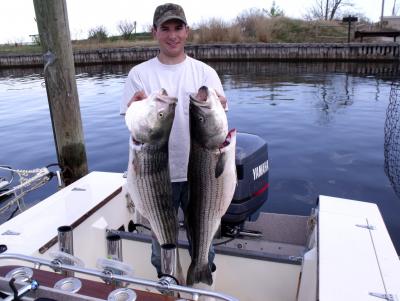
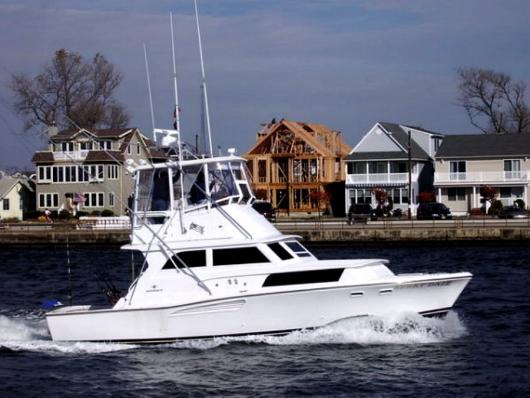
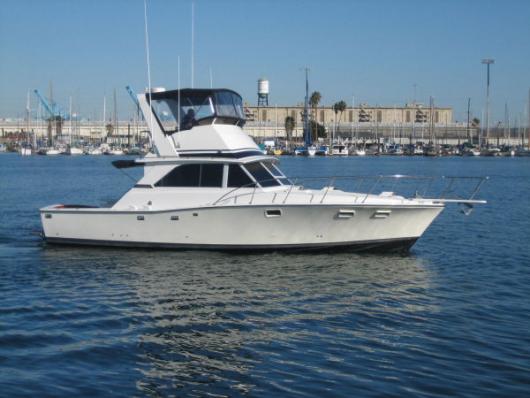
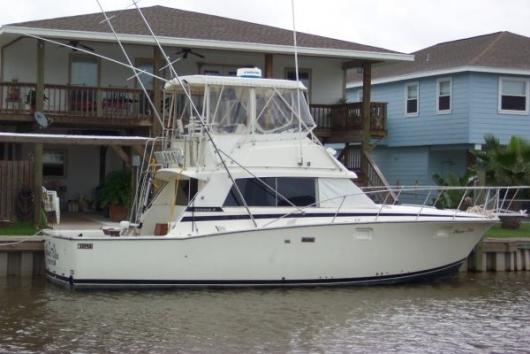
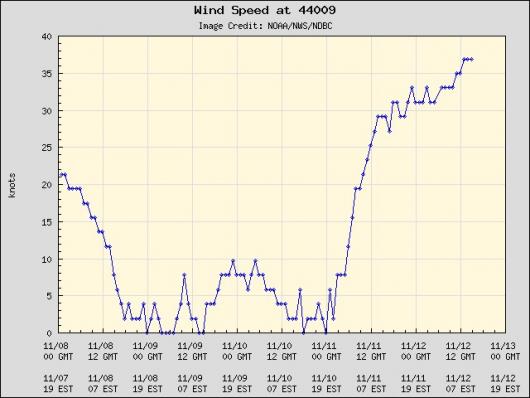
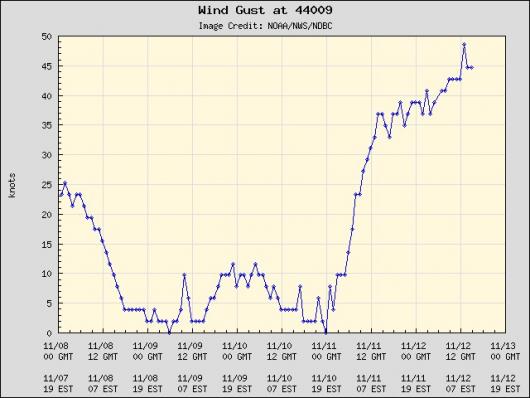

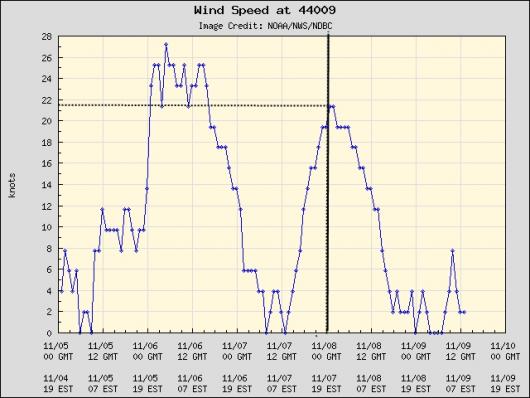
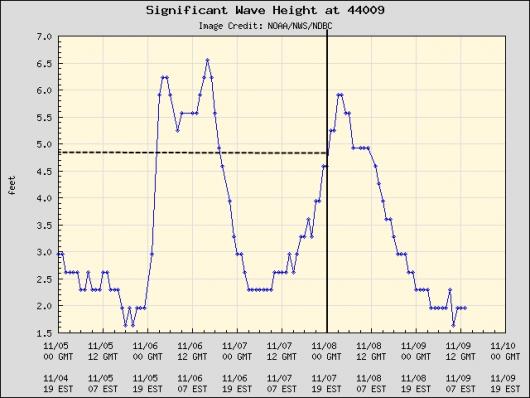
Nice, relaxing day
in Boating and Fishing Discussion
Posted
Was invited out this morning, on Capt. Pete Ferraro's Fishin' Inferno, out of Leonardo State Marina. Had a nice day out on the water, as we caught over 30 Stripers, only one of which was a short. The majority of the fish ran between 15-20 pounds, with a few over twenty, and one that we estimated at 30. We released all but three.
Caught a few on a 30 year-old ABU 5600/Fenwick popping rod combo, topped off with 12 lb test....a real blast on fish of this size.